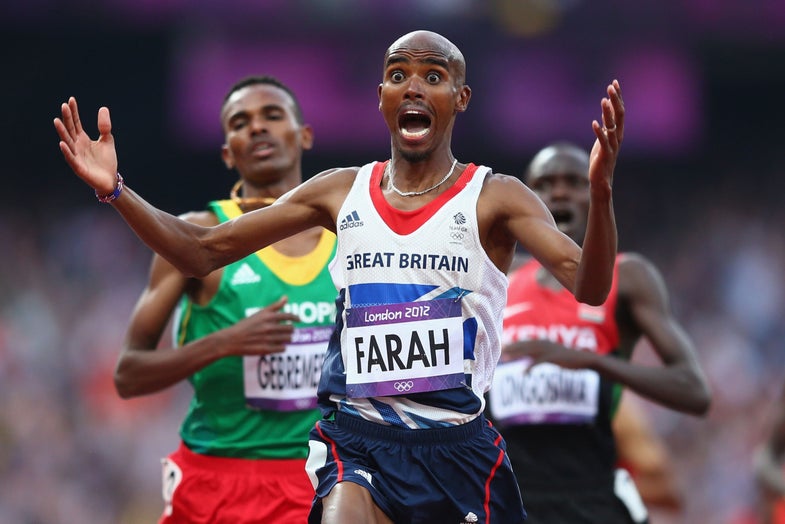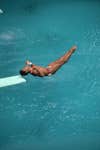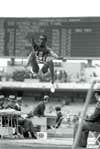Interview: Behind the Scenes with Getty Images Sport at the 2016 Summer Olympics
Ken Mainardis explains the massive task of photographing the Olympics—before the first picture is taken at Rio


Olympics Day 8 – Athletics
It’s not uncommon to hear about all the work that sports photographers put in during the 16-day grind that is the Olympic Games, but it’s not often we hear about all the work that goes on behind the scenes. Ken Mainardis is the vice president of sports imagery and services for Getty Images, and it’s his responsibility to make sure all those iconic images can be processed, edited, and sent out to clients as fast as possible. It turns out, that’s a rather Herculean task. We talked to Mainardis about what it takes to make an entire city ready for some of the world’s best sports photographers.
How long have you been working in the sports photography world?
I have been with Getty since June 2004, just before the Athens Olympics. Previous to that I was at Reuters for 10 years. I actually started as an assignments editor at Reuters all those years ago.
You must have seen a crazy amount of change in the industry over that period of time.
My first games was Atlanta in 1996. We were dev’ing [short for developing film] in Atlanta. It was all chemicals and canisters of film. They were going to Kodak to be dev’d, then we would scan rolls and rolls of film to get something out. In ’96 it was taking about 40 minutes from when something happened. Today we can do that in about 120 seconds to customers around the world. [Laughs] That is the journey I have been on from 1996 to 2016 over 20 years.
Considering the quantity and volume of film and the process involved, 40 minutes actually still seems pretty fast.
Forty minutes was quick. That was us working at our top speed. There was low-priority stuff that would come back days later in ’96. [Laughs] We edit every frame live now. And “every frame” means around 1.5 million images across the 16 days of the games. And those 1.5 million images are edited down to around 80,000 finished pictures that we send to customers. So, you can see that the editors are as much stars as anybody else in that process. To be able to edit that kind of quantity down to a product that makes sense is an incredible skill.
That’s a crazy amount of work. Is there a ratio of editors to photographers that you have in order to manage it all?
In the old days that was much more common to have a ratio of what we used to call wire technicians to photographers, but these days it’s much more based around the schedule. Our editing team will be 18 in Rio. They’re really focused and created around the schedule in order to make sure that we have editing people on the highest-profile events.

September 1, 1988
Just 18 editors for all those images? That’s pretty impressive. How much editing do the pictures typically get?
We get untreated JPEGs from our photographers. We don’t move Raw files. Our editors select the picture with essentially one tap of the keyboard. A second editor then opens up the image and does some very simple Photoshop correction on color and contrast, and a crop. Then that picture moves down the production line to someone who adds metadata and captions it. That whole process, from the tap to select the image to the caption, is through in 30 to 35 seconds. These folks really are incredibly honed at what they do. They’re making sure they’re choosing the right pictures and sending them out to the right clients.
Is the software you’re using to do the sorting and selecting something that’s custom for Getty?
Yeah, that’s a proprietary piece of software that we have developed ourselves for our specific purposes.
It must be a challenge to store all that data that’s coming in from so many directions.
That’s right. We do store them all and we store them twice, just in case we lose one, as well. I don’t have the numbers in front of me, but every games, as camera file size increases, that becomes more terabytes on more terabytes on more terabytes.
Is there a standard camera kit that the photographers will be using to try and keep things consistent?
We actually give our photographers a choice. We believe they’re the world’s best and, as the world’s best, we believe they should be able to choose the equipment they’re most comfortable with. Essentially they all choose the Canon or Nikon top-of-the-range DSLR. Both of those cameras are extraordinary pieces of kit these days. They’re extraordinary. But, most importantly, they’re networkable. Both cameras allow you to plug in an ethernet cable. The cameras become part of the network, which is why we’re able to get the pictures from our photographers so quickly.
You must have done a fair bit of infrastructure work, then, to make sure all that networking stuff is in place well before the games.
I think that’s probably the biggest single project that we undertake at the games. We start planning that infrastructure the moment the games are awarded to a host city. So, this goes back to Copenhagen seven years ago. Almost immediately after the decision, we start to work with the organizing committee and the IOC to develop the transmission network that facilitates our needs and essentially connects all the key photo positions at the venues back to our office in the main press center. Basically it’s a hub-and-spoke network, which means that from all the key positions—the finish line at the track, ringside at boxing, the pool deck at the swimming, all these key positions—allow the images to come straight from the camera to the editors and allow us to make much better use of our editing resources than we ever used to.
Obviously, going back before we had this network, our editors spent a lot of time moving between venues and not editing. They now edit the whole time.

August 11, 2012
So, if you’re a photographer, does every shot that you take end up making its way back to the editors?
Exactly. It’s a brutal world. Every single shot is seen by the editor. There’s no more hiding. [Laughs]
Does the fact that all the photos go back to the editors change the way that the photographers shoot? Those top-end DSLRs can do 14 or 15 frames per-second, but they obviously don’t want to be sending massive piles of nearly identical images back to the office and hindering the editing process.
The same principles apply as they have always applied to great sports photography. You shoot what’s important. You wait for it to make pictures. We’re all still firm believers that machine-gunning action for the sake of machine-gunning action doesn’t actually make great pictures. We’re fortunate to work with the world’s best, who are able to know exactly when the right time is to let fire and when it’s right to wait. That is really why this system works. If you just flood your editor with tens of thousands of frames of everything you’re seeing, then you’re not really photographing the event. You’re just kind of recording it.
That’s basically just a collection of small, choppy videos at that point.
Exactly. And as you rightly say, it makes it impossible for the editor to actually pick out the really good stuff.
Sure, you’re always looking for that exact peak moment and that’s probably very difficult if there are tons of similar frames.
The really great sports photographers have a true appreciation for the action that’s going on in front of them. They can get a sense of the way the event is moving. They understand the rhythm of the sport. We believe really strongly in having sport-specialist photographers who really understand the subject matter. You’d expect a writer to understand their subject matter as opposed to a generalist, and it’s the same for a photographer. They have a second sense of when that action is about to become worth shooting.
Is that how you choose the photography assignments for the shooters?
It’s two things really. First and foremost, they’re all sports specialists. They don’t do anything all year long except sport. There’s an enormous competition in the first place to get on the team. They’re all very, very, very good at what they do. Having said that, there are particular subject-matter specialists. We have underwater specialists and sailing specialists. We have a rugby specialist for Rio because it’s in the games for the first time. We have golf specialists because golf is in the games for the first time. Certain sports, especially something like sailing, no matter how good a photographer you are, unless you really understand sailing when you’re bobbing around on a chase boat, you really have no chance.
How do you handle image transmission for something like sailing? Are you using wireless or old-school card running?
It’s a mix of both actually. We do set up as much Wi-Fi as we can from the chase boat back to the dock, where the network is installed. We get as much connectivity as we can. The photographer wouldn’t send everything in that situation; they would make selections from the back of the camera. In particularly difficult weather conditions or if they become stretched out in the field, then they would basically bring a card back to store and we would spool the cards back to the editors.
One trend that seems to have emerged over the past couple of Olympics is fancy new camera technology such as robotic cameras. Will we be seeing any exciting new tech in Rio?
I think there are really two key developments for Rio and they’re really continued developments rather than totally new tech. We were the first agency really to push the robotic angle ahead of the London games in 2012. We did a little bit of it and we’re really ramping that up in Rio. We have 20 locations that will be equipped with robotic rigs. We have all been putting remotes in roofs in different locations for quite some time. A robotic rig gives you full response as if you were holding it in your hands. Putting a traditional camera in the rafters involved a tremendous amount of luck when actually making the picture, while with a robotic camera you’re narrowing the odds. The chances of making something really strong are very high. You can also put a camera in a place that’s inaccessible to humans: It can be mounted on the ground and then lifted on a truss or a crane.
The other piece of kit, and I don’t think it will come as a surprise, is VR. It’s absolutely taking off in our view driven by readers’ desire to become immersed in photography—in the environment. We have been shooting VR and 360[-degree images] since 2012, but this games we will be doing much more of it. Every one of our editorial photographers will be carrying a small 360 camera that enables them to do an interactive 360 and have that uploaded in a matter of seconds to our editors and then uploaded to our site. To me, it’s a fascinating development because the history of photography was always about a moment right back to the late 19th century. Over time that developed right up to the birth of digital where we started telling stories with pictures in large volumes. Thousands of pictures in some cases would tell a narrative. Now, there’s a move back to a single image interactivity because it gives you the opportunity to really explore a picture for longer. That has become possible through 360s. For me, it’s fascinating and we’re on the cutting edge of that, I think.
That’s something we have been starting to see a lot. Things like what the New York Times has been doing in conflict zones have been fascinating. Big events like this also seem like they’re perfect for this kind of tech.
I think that sometimes we forget that our photographers stand in places most of us would dream to stand in. What we actually see through a normal camera is a moment in time but you don’t get a sense of where they actually are. 360 gives the user a genuine experience of what it’s like to be standing at the finish of the 100 meters final. We did one recently with Danica Patrick, the race car driver, inside her car. It gives people a real insight into the access we get.

October 18, 1968
Do you have a personal favorite Olympic image that stands out in your mind?
I think it would be the very first picture taken by our company at the Olympic games back in 1968. The story goes that a photographer from London called Tony Duffy was actually on vacation in Mexico City and managed to get himself into the venue with a camera. He was really a camera enthusiast rather than a professional at that point. He got himself at the end of the long jump pit as Bob Beamon broke the world record. It’s one of the most famous world records ever and stood for more than 20 years after that.
Tony took this picture back to London after his vacation and he didn’t really know what to do with it. It’s an incredible picture. He showed some friends and colleagues and people who worked in newspapers and they said, “What are you doing with this? You should sell this!” He sold it for really great money and founded the business that became Getty Images Sport with that single image. For me, the very first Olympic image is the start of our DNA.
Is that emotion really the crux of what makes a great Olympic photo?
I think there are so many things, but moments really are the key still. You have to be able to capture the moment. It’s not the fraction of a second before. It’s not the fraction of a second after. It’s the decisive moment where you can say “that was exactly when history turned on its axis.” That’s what makes the skill of the world’s best photographers so incredible. It’s far from routine, but they routinely capture those moments.
If you could give some advice to an aspiring sports photographer who dreams of one day getting an assignment like shooting the Olympics for Getty, what would it be?
I would say don’t get obsessed with kit. Yes, get yourself some decent kit. Yes, get a decent kit, but don’t become obsessed with it. Don’t get obsessed with events. Don’t worry about going out to the biggest events or even pro events to shoot sport. Go out to your local rec or park and shoot amateur sport. Find yourself somebody who is in the business to show that material to and seek feedback and listen. Think about the basics. Think about great composition. Think about peak action and body shape. Think about clean backgrounds and getting it sharp. Once you start doing those things and getting feedback from a pro, you’re going to start improving really, really quickly. We always say, don’t get obsessed with the trappings of the job—big fancy equipment and big events. To get the basics, start practicing shooting whenever you can and whatever sport you can. It will all help in the long run.
**
